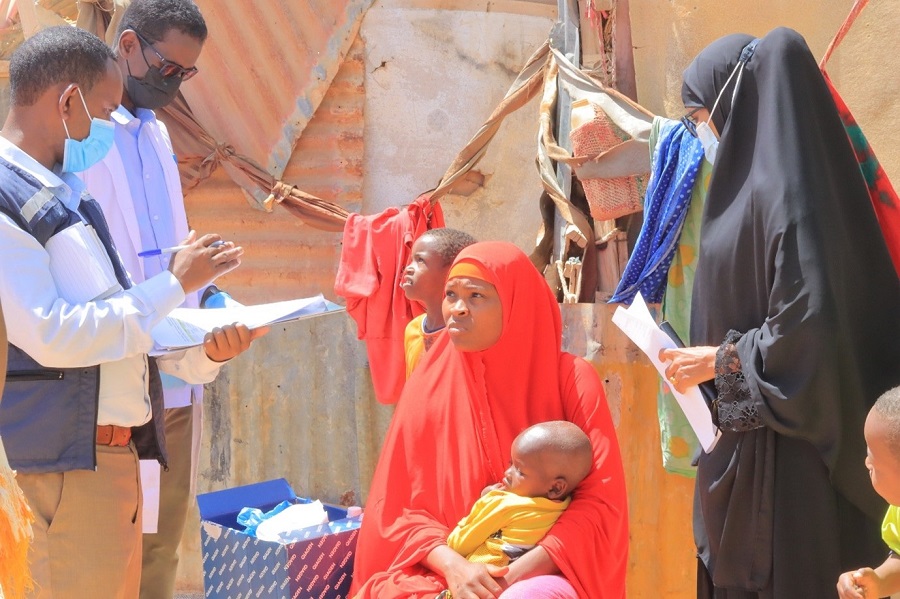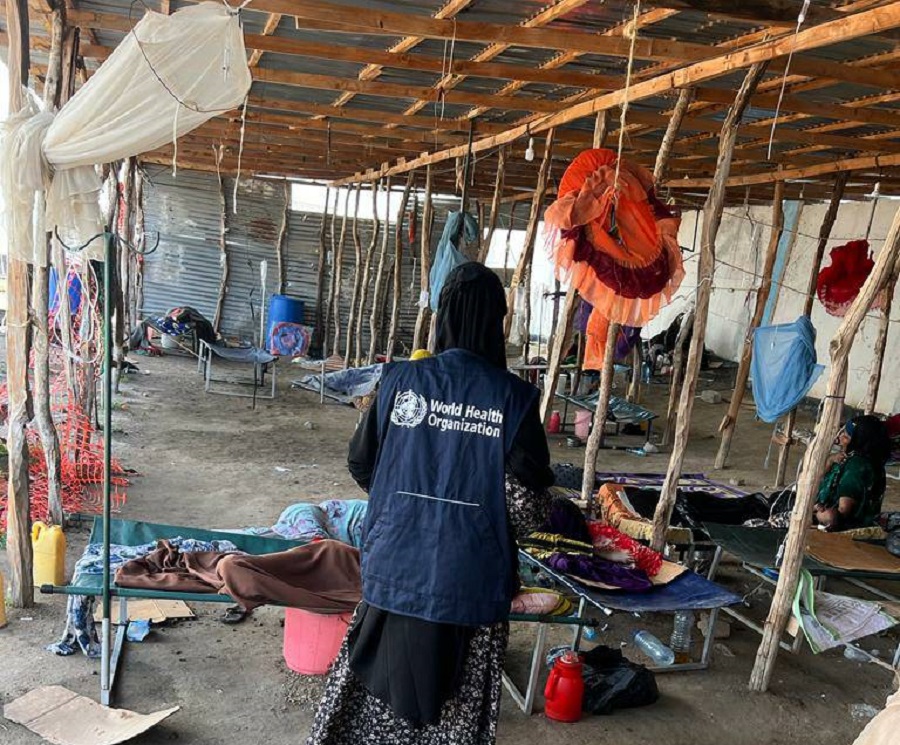
WHO-supported community health workers help connect communities with nearby health facilities to win hearts and minds of locals. Credit: WHO/Somalia
Mogadishu, 15 April 2023 – The World Health Organization (WHO) Somalia with the timely support of United Stated Agency for International Development (USAID) is helping the Ministry of Health to strengthen and expand the community-based surveillance system in underserved areas, which is essentially addressing the health system gaps and bridging a vital clog between these communities and health system.
Community health workers are being effectively used in crisis affected countries to bridge the health system gaps for surveillance when there is an acute shortage of health care workers. Learning from its successful intervention to control the community spread of COVID-19 in Somalia, WHO country office has supported the Federal Ministry of Health to deploy over 2100 community health workers (CHWs) and 237 rapid response teams (RRTs) across Somalia. With funding support from USAID, these CHWs and RRTs form the backbone of the community-based surveillance system which has been established last year to support the facility-based surveillance system of EWARN in the country for rapid detection, identification and reporting of COVID-19 cases, including other epidemic-prone diseases in the communities living in underserved and hard-to-reach areas.
“This COVID-19 plus effort by WHO is resulting in multiple benefits ranging from confidence building measures between the government and the communities, as well as in restoring our fragile health system. There, surely, was no other way to achieve these 2 milestones and I am sure that donors like USAID will continue to help us sustain such game-changing efforts,” said Dr Mukhtar Abdi Shube, National EPI Manager for Federal Ministry of Health.
These WHO-supported community health workers, almost half of whom are women, report through a mobile phone-based application for community-based surveillance. This network of CHWs was primarily established during COVID-19 pandemic to raise alerts and awareness using risk communication and community engagement activities.
However, due to prolonged drought, which has already impacted over 8.25 million people and displaced over 3.5 million across the country, WHO Somalia has helped the COVID-19 focused community-based surveillance system to graduate to a new level by including 12 epidemic prone diseases and events. After consultation with Health Cluster partners and the Federal Ministry of Health, WHO held a series of capacity-building workshops to help the existing workforce of CHWs to learn the basics of reporting on 12 prioritized diseases including COVID-19, cholera, measles, malaria, tuberculosis (TB), HIV using a syndromic-based case definition.
 A WHO-supported cholera treatment centre in the border areas of Lower Juba region is treating patients referred by the community health workers from the neighbouring districts. Credit: WHO/Somalia
A WHO-supported cholera treatment centre in the border areas of Lower Juba region is treating patients referred by the community health workers from the neighbouring districts. Credit: WHO/Somalia
“WHO has helped us to rediscover the broken health system in Somalia by supporting us to train and deploy these front-line health workers across the country. These locally hired community health workers and vaccinators have literally helped us get in touch with the communities and for the first time we are realizing the depth and scale of the public health issues confronted by the communities,” commented Dr Bashir Ahmed, District Public Health Officer managing the cholera treatment centre in district Afmadow in Lower Juba region.
A positive by-product of this network is that it has become a functional linkage between the communities and the health system as these community health workers are referring severely malnourished children to one of 64 WHO-supported stabilization centres, serious cholera patients to one of 10 WHO-supported cholera treatment centres, pregnant women to nearby reproductive, maternal, neonatal, child and adolescent health centres or helping midwives to facilitate home-based deliveries and promoting routine immunization, as well as vaccinating zero dose children.
WHO Representative to Somalia, Dr Mamunur Rahman Malik, believes that, “These community health workers are a means to an end. They are serving as a kingpin to revive the confidence of communities in the health system, as well as helping the federal and state ministries of health to get a hand on the pulse of communities, understand their real health needs, and rapidly becoming a vital clog between the underserved communities and the fragile health system in the country.”
Community health workers across African settings have been known for extending health services at community level particularly in underserved or remote populations. The community health workers in Somalia and other humanitarian crisis-affected countries are also filling the acute human resource gaps and deliver public health services directly to underserved communities as part of outbreak and pandemic response for preventing infections and reducing spread. By virtue of their understanding of the local context in the community and trust they garner from the people they serve, the community health workers are increasingly becoming useful and effective for the response to COVID-19 and other epidemic-prone diseases.
This community-based network of health workers and rapid response teams has given the confidence to the Government to replicate it in the newly liberated areas across Somalia. In the past one year alone, these WHO-supported community health workers have visited a total of 2 029 611 households with the preventive health messaging. A total of 20 909 alerts were reported by these CHWs of which 10 174 were investigated. They screened 328 519 children for malnutrition, of whom 97 786 were referred to health facilities for necessary treatment while another 19 807 children were also referred to these health facilities due to severe respiratory issues and/or dehydration. They also provided iron and folic acid supplements to 95 524 pregnant women, while zinc and vitamin A supplements to over 145 491 children.
How the CHW network works in Somalia
WHO Somalia, together with the Federal Ministry of Health and other UN agencies, conceived an integrated health response to the drought and COVID-19 pandemic by improving access to essential health care across 48 priority districts in the country. WHO deployed these community health workers as part of this initiative to increase access to essential health care for the communities living in marginalized and underserved areas of these 48 districts.
Now, these community health workers are being trained on case detection for epidemic prone diseases beyond COVID-19, provide home-based care for children with diarrhoea, malaria, TB, HIV, and other ailments, and identify danger signs, especially among children and women, and refer them to the nearest health facility.
Since they were locally recruited and enjoyed the trust of the locals, they were also trained on delivering a range of culturally appropriate risk communication and community engagement messages on healthy living, water, sanitation and hygiene (WASH), nutrition and infant and young child feeding during house-to-house visits besides helping the state-based health authorities detect epidemics as early as possible and reduce the turnaround time for response.
To compliment the work of community health workers, WHO Somalia has also established an oversight and mentoring mechanism by deploying district-based rapid response teams. From an initial deployment of 171 teams, WHO increased the numbers to 237 teams during the pandemic. These rapid response teams include a surveillance officer, a laboratory technician, and a social mobilization officer from the districts. These teams serve to verify alerts reported by CHWs and investigate credible alerts with sample collection. RRTs are also responsible for providing supportive supervision to health facilities through the Early Warning Alert and Response Network (EWARN) system and monitor the activities of the CHWs at the household level and at various points of entry.
To meet the increased demand of the health services, WHO is maintaining the operational response capacities of 281 health facilities across the country by supporting these facilities with 64 stabilization centres, 10 cholera treatment centres, 15 oral rehydration points in Somalia. These health facilities are being supported with the provision of essential medical supplies like interagency emergency health kits, trauma kits, cholera kits, severe and acute malnutrition kits to treat children with health complications, and oxygen concentrators.
==============================
Note to editors
Since December 2021, Somalia has been experiencing an escalating drought that has affected 8.25 million people and displaced over 3.25 million people in search of humanitarian assistance. Over 6.4 million people (38% of the total population) do not have access to safe water and proper sanitation. The situation is worsened by protracted conflicts and the COVID-19 pandemic that has led to further weakening of an already under-resourced and under-staffed health system leading to a higher proportion of people with limited access to primary health care services.


